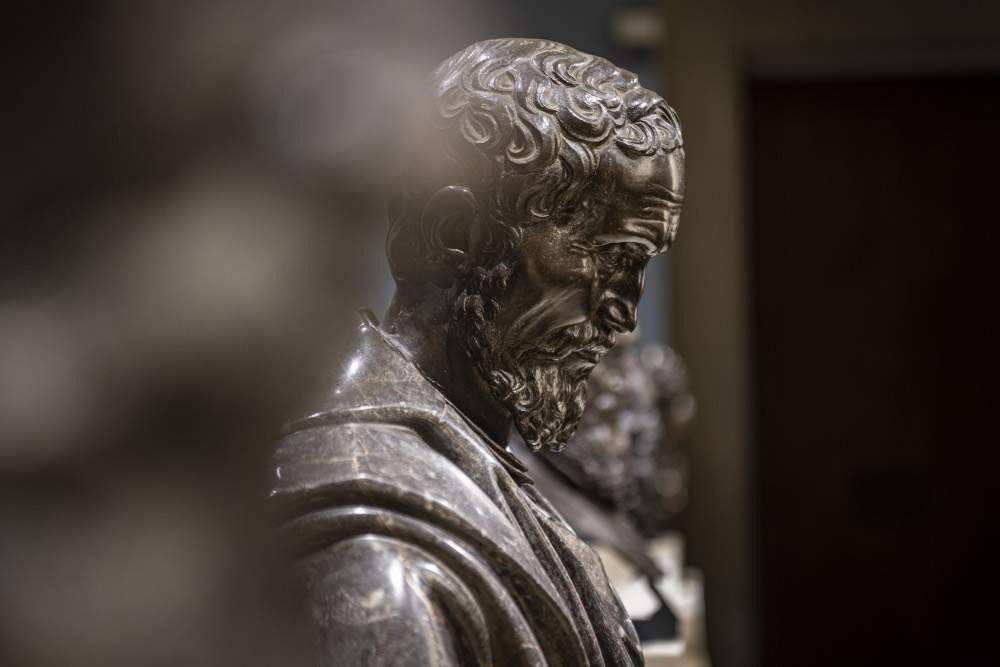Florence, Michelangelo's bronze busts attributed to Daniele da Volterra on display
From Feb. 15 to June 19, 2022, the Galleria dell’Accademia in Florence presents the exhibition Michelangelo: the bronze effigy of Daniele da Volterra, curated by Cecilie Hollberg, made possible thanks to the support of Intesa Sanpaolo, with the museums Gallerie d’Italia, and Intesa Sanpaolo Innovation Center.
Daniele Ricciarelli, known as da Vol terra (Volterra, 1509 - Rome, 1566), was a pupil of Michelangelo and was bound to him by deep friendship. Leonardo Buonarroti, Michelangelo’s nephew, commissioned two bronze portraits of his uncle soon after his uncle’s death, to which was added a third request made by his friend and antiquarian Diomede Leoni. Da Volterra died in 1566 without having finished the three promised heads. The problem of the chronology and casting of Michelangelo’s bronze effigies has long remained in the field of art history studies a point to be clarified; indeed, substantial uncertainty remains about the provenance of the many existing examples.
The exhibition will see the nine bronze busts of Michelangelo, attributed to Daniele da Volterra, displayed in one location. Along with the three works already housed at the Galleria dell’Accademia, the Museo Nazionale del Bargello and Casa Buonarroti, there will be important loans from various international and Italian museums, such as the Musée du Louvre and the Musée Jacquemart-André in Paris, the Ashmolean Museum in Oxford, the Capitoline Museums in Rome, the Castello Sforzesco-Civiche Raccolte d’Arte Applicata in Milan and the Museo della Città “Luigi Tonini” in Rimini.
“The idea for this exhibition stems from the need to make a scholarly contribution with respect to the complex relationship between originals and derivations,” said Cecilie Hollberg, director of the Galleria dell’Accademia in Florence."Michelangelo: the bronze effigy of Daniele da Volterra is a unique and unusual exhibition that aims to answer still open questions thanks also to the use of highly technological and innovative tools. The starting point of this epoch-making project on Michelangelo Buonarroti and his pupil Daniele da Volterra was the reorganization and restoration of the bust preserved in our museum in 2017. We are therefore taking this opportunity to offer for the first time a direct comparison of the nine busts bearing Michelangelo Buonarroti’s features, to review their data, documents and related bibliography. Almost five centuries later, it is time to find answers."
For the exhibition project, all the specimens featured were subjected to an intensive campaign of non-invasive analysis, both classical of the materials and using sophisticated state-of-the-art instruments and innovative methodologies. Scientific investigations never previously carried out on these works were conducted, such as geological analysis of the melting grounds or nuclear analysis (XRF) to determine the nature and composition of the metal alloys. The fruitful and close collaboration with Mario Micheli, professor of history and technique of restoration at Roma Tre University, a well-known expert in the field who has already worked on the Riace bronzes and the Capitoline she-wolf, together with a team composed ad hoc, opened up new approaches.
Each head was digitized and 3D printed in resin at a scale of 1:1, thanks to Factum Foundation for Digital Technology in Conservation, a Spanish nonprofit organization specializing in new technologies for the preservation of cultural heritage; it was digitally “mapped” at key points and correspondences, overlaid and compared in a complex research effort that combined digital expertise with academic rigor in identifying the original works, named in the inventory of the house inhabited by Daniele da Volterra, and the genealogy of variants derived from them.
The exhibition has a scientific committee of international experts consisting of Antonia Bostrom, Alessandro Cecchi, Mario Micheli, Claudio Parise Presicce, and Dimitrios Zikos.
A study day involving leading experts will be held on February 21, 2022. The main objective of the exhibition is to produce the first scientific catalog of the bronze effigies attributed to Daniele da Volterra, published by Mandragora, which will come out after the study day, within which the research carried out so far and the results of the diagnostic investigations will converge. Among the expected results is to set up an accurate genealogy of the variants derived from Michelangelo’s busts, identifying as far as possible the provenance and characteristics of the various executions.
For more info: www.galleriaaccademiafirenze.it
Hours: Tuesday through Sunday, 9 a.m. to 6:45 p.m. Closed Mondays. Reservations required on Saturdays and Sundays.
Photo by Guido Cozzi
 |
| Florence, Michelangelo's bronze busts attributed to Daniele da Volterra on display |
Warning: the translation into English of the original Italian article was created using automatic tools. We undertake to review all articles, but we do not guarantee the total absence of inaccuracies in the translation due to the program. You can find the original by clicking on the ITA button. If you find any mistake,please contact us.



























